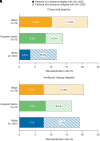Use of Race-Specific Equations in Pulmonary Function Tests Impedes Potential Eligibility for Care and Treatment of Pulmonary Fibrosis
- PMID: 38386005
- PMCID: PMC11298987
- DOI: 10.1513/AnnalsATS.202309-797OC
Use of Race-Specific Equations in Pulmonary Function Tests Impedes Potential Eligibility for Care and Treatment of Pulmonary Fibrosis
Abstract
Rationale: The use of race-specific reference values to evaluate pulmonary function has long been embedded into clinical practice; however, there is a growing consensus that this practice may be inappropriate and that the use of race-neutral equations should be adopted to improve access to health care. Objectives: To evaluate whether the use of race-neutral equations to assess percent predicted forced vital capacity (FVC%pred) impacts eligibility for clinical trials, antifibrotic therapy, and referral for lung transplantation in Black, Hispanic/Latino, and White patients with interstitial lung disease (ILD). Methods: FVC%pred values for patients from the Pulmonary Fibrosis Foundation Patient Registry were calculated using race-specific (Hankinson and colleagues, 1999), race-agnostic (Global Lung Function Initiative [GLI]-2012), and race-neutral (GLI-2022 or GLI-Global) equations. Eligibility for ILD clinical trials (FVC%pred >45% and <90%), antifibrotic therapy (FVC%pred >55% and <82%), and lung transplantation referral (FVC%pred <70%) based on GLI-2022 and GLI-2012 equations were compared with those based on the Hankinson 1999 equation. Results: Baseline characteristics were available for 1,882 patients (Black, n = 104; Hispanic/Latino, n = 103; White, n = 1,675), and outcomes were evaluated in 1,531 patients with FVC%pred within ±90 days of registry enrollment (Black, n = 78; Hispanic/Latino, n = 72; White, n = 1,381). Black patients were younger at the time of consent and more likely to be female compared with Hispanic/Latino or White patients. Compared with GLI-2022, the Hankinson 1999 equation misclassified 22% of Black patients, 14% of Hispanic/Latino patients, and 12% of White patients for ILD clinical trial eligibility; 21% of Black patients, 17% of Hispanic/Latino patients, and 19% of White patients for antifibrotic therapy eligibility; and 6% of Black patients, 14% of Hispanic/Latino patients, and 12% of White patients for lung transplantation referral. Similar trends were observed when comparing the GLI-2012 and Hankinson 1999 equations. Conclusions: Misclassification of patients for critical interventions is highly prevalent when using the Hankinson 1999 equation and highlights the need to consider adopting the race-neutral GLI-2022 equation for enhanced accuracy and more equitable representation in pulmonary health care. Our results make a compelling case for reevaluating the use of race as a physiological variable and emphasize the pressing need for continuous innovation to ensure equal and optimal care for all patients regardless of their race or ethnicity. Clinical trial registered with www.clinicaltrials.gov (NCT02758808).
Keywords: PFT; access to health care; interstitial lung disease; race.
Figures



References
-
- Wijsenbeek M, Cottin V. Spectrum of fibrotic lung diseases. N Engl J Med . 2020;383:958–968. - PubMed
-
- Meghji J, Mortimer K, Agusti A, Allwood BW, Asher I, Bateman ED, et al. Improving lung health in low-income and middle-income countries: from challenges to solutions. Lancet . 2021;397:928–940. - PubMed
-
- Pellegrino R, Viegi G, Brusasco V, Crapo RO, Burgos F, Casaburi R, et al. Interpretative strategies for lung function tests. Eur Respir J . 2005;26:948–968. - PubMed
Publication types
MeSH terms
Associated data
Grants and funding
LinkOut - more resources
Full Text Sources
Medical

